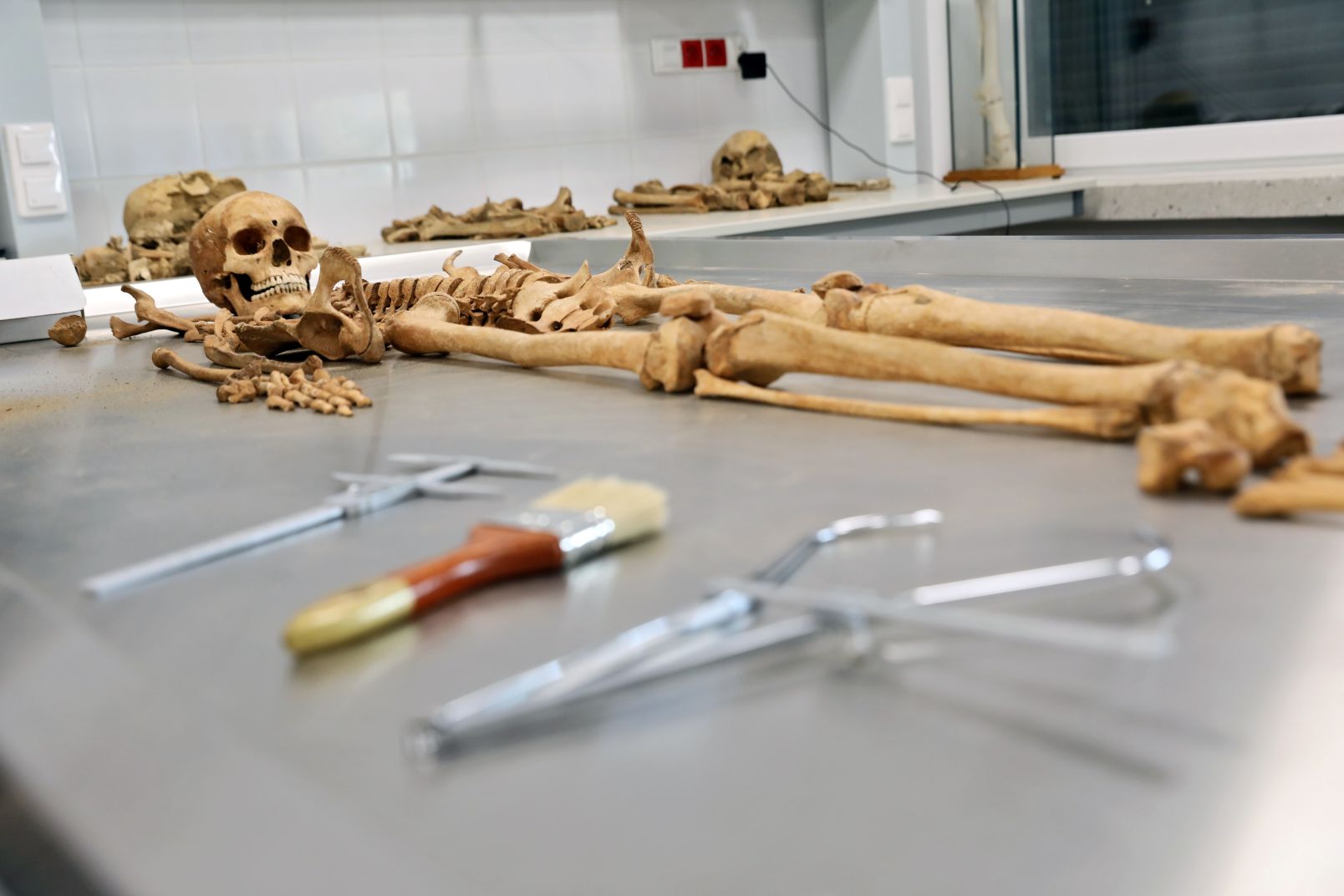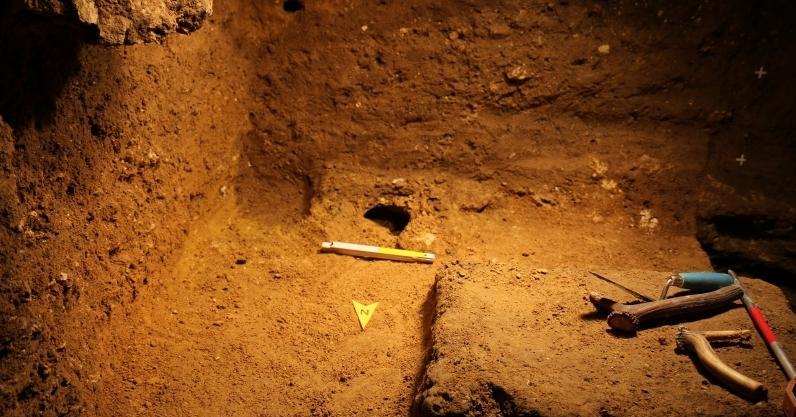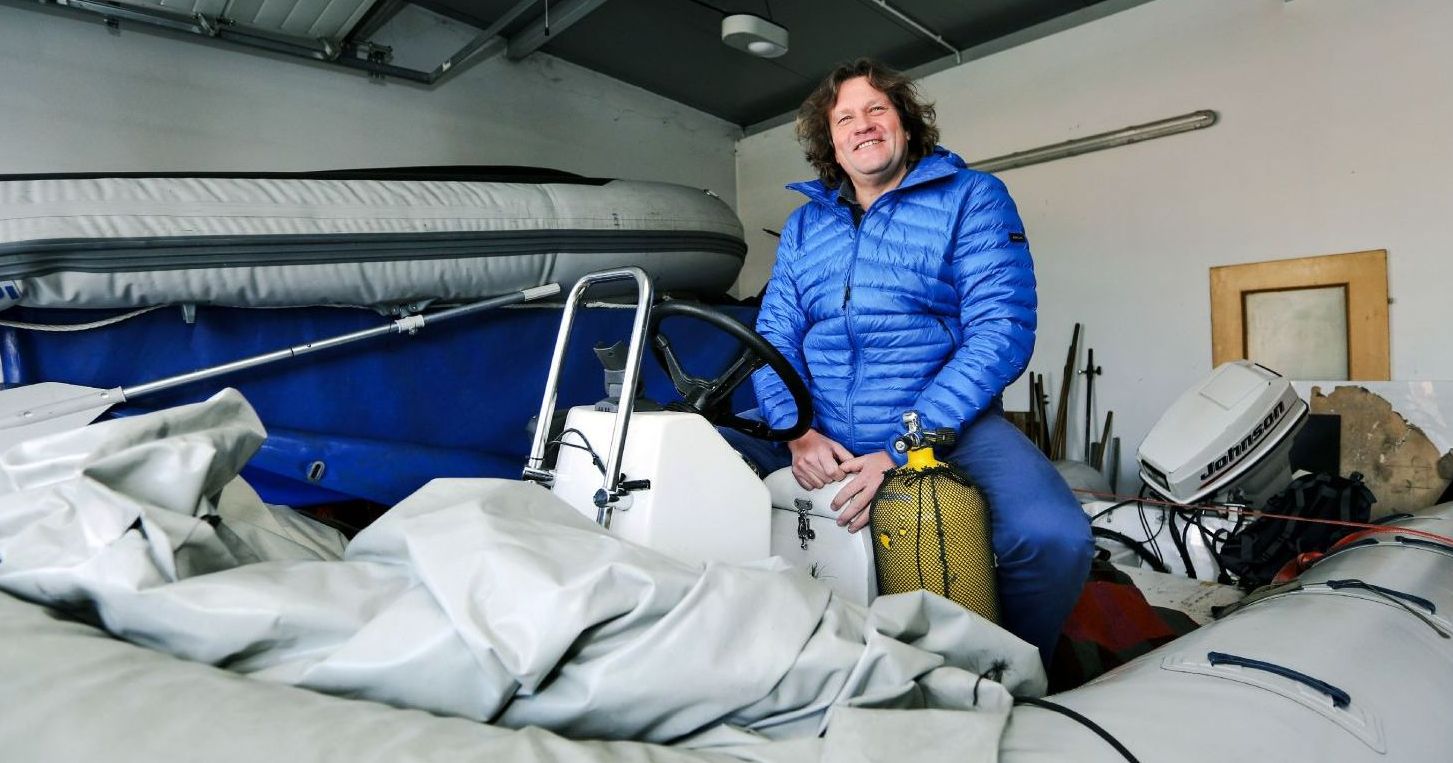 Humanities and arts
Humanities and arts
Keep demons in the grave
A young woman's skeleton with a triangular padlock on her toe and a sickle on her neck was found by scientists from the NCU on a burial site in the village of Pień near Dąbrowa Chełmińska. Artefacts indicating the performance of anti-vampire practices in that area had been found during archeological excavations even earlier.
Wooden stakes, garlic, silver weapon, and sunlight are only a few means of combating vampires described in fiction. Both fictitious characters in literature and people living in the past were scared of those creatures. For this reason, those suspected of having supernatural powers were often buried in a specific way, i.e. with their faces down, tied with ropes in the fetal position, decapitated, pressed to the ground with a rock, or with their chests stabbed. Scientists also found padlocks and keys in graves, which were to prevent the dead from returning to the world of the living and close a certain stage so that a dead child, for example, would not take others to the netherworld.
Unusual finding
In the village of Pień, scientists from the Nicolaus Copernicus University in Toruń found a female skeleton which was dually protected so that the deceased would not rise from the grave. Those who buried the woman put a triangular padlock on her left big toe and additionally pinned her neck to the ground with a sickle. The tool did not harm her since her head was not cut off and the backbone remained in the pristine condition. Media soon named the skeleton a 'vampire'. This is a very catchy name for our finding, but not exactly true.
"Our discovery does not necessarily indicate that a vampire was buried at that site, explains the head of the research, dr hab. Dariusz Poliński, Prof. NCU from the Institute of Archaeology at the Nicolaus Copernicus University. I would prefer to consider these practices as anti-vampire procedures. The woman could possibly have some physical impairment or mental disorder and was thus mistreated by her neighbors who thought she would scare them after death.

photo: Andrzej Romański
When members of a given community were suspicious, they occasionally decided to open the grave and add such anti-vampire artefacts. In this case, no further tampering with the grave is visible. The scientists also noticed mysterious greenish spots on her palate which could indicate contact with an object made of copper or copper alloy. Had it been a coin, it could have been placed as the third means of protection against her return to the world of the living.
As far as this burial site is concerned, we have already found coins in the graves and, indeed, they were put into the mouths of the deceased. For example, we found a silver crown półgrosz of John I Albert dated back to 1492–1498 and one-and-a-half of a silver crown grosz of Sigismund III Vasa from 1626, says Prof. Poliński.
So, what do we know about the woman buried with the sickle on her neck?
She was between 17 and 21 when she died. "The girl's bones are indicative of it, explains an anthropologist and archeologist, dr Alicja Drozd-Lipińska from the Institute of Biology at the NCU Faculty of Biological and Veterinary Sciences. Not all the epiphyses became fused with the shafts of the long bones. Certain pathological and developmental changes can be observed on the skeleton, but further detailed analyses are required to decide what caused them and which effects they brought."

photo: Andrzej Romański
Researchers consider the claim that the woman became a victim of some execution or punishment (for example witchcraft) unsubstantiated as the woman was buried with care, probably in a coffin, although no remains of wood were found in the excavation site. Still, a visible contour of a pillow underlying her head was observed, which can suggest a high social status of a family she was born in.
Her head was covered with a bonnet, probably made of silk, because remains of this material were found in the site. The bonnet was decorated with a silver or golden (so-called) weft.
Yet another detail drew the archeologists' attention, namely, the girl's left arm was not placed along her body, but turned left. It is one more mystery to solve.
"We are preparing to carry out detailed analyses, informs dr Drozd-Lipińska. The skeleton requires cleaning from sand. It has to undergo further examinations and analyses which may help us decide whether there were any biological symptoms which made her countrymen regard her as “different".
Stones and coins
The grave from Pień equipped with devices described as 'anti-vampire' in literature is not an exception found at that site. So far, researchers have discovered more than sixty burials from the 17th century, over a dozen early medieval ones, and a horse burial there. The burial site was accidentally discovered. A team led by Prof. Poliński examined that area looking for remains of an early medieval castle town and Teutonic procuratorship from the 15th century.
"Having finished our duties, we went up the hill to admire the Vistula valley and take a look at Fordon located on the opposite bank of the river, reminisces the anthropologist. It is said that bones whiten under the sun, and it was so in this case. On a prominence, on the edge of a sandpit, we noticed human bones sticking out from the ground."

It was not the first discovery of such kind there. The first documented findings (two skeletons with decorations) were discovered on the burial site in 1941. Later on, local inhabitants mentioned that last century, in the 60s, when a state collective farm (PGR) was built in Pień, a railways technical school student found human bones there and informed conservational services. Then, a sickle was found in one of the graves, but it was rather associated with the early medieval period. Regarding the current state of knowledge, it possibly was another grave with 'anti-vampire' artefacts.
Unfortunately, we cannot verify the information because the sickle is missing, says Prof. Poliński. In the Bydgoszcz City Museum, there is only a note prepared by dr Gerard Wilke in which he indicated the place on the hill where two skeletons, one of which equipped with a sickle or a half-scythe, were found.
In 2005, the archeologists from the NCU established an exploratory excavation site on the hill and started examinations aimed to save possibly many historical graves. As a result, they found remains of two other burial sites, i.e. an early medieval one from the turn of the 10th century and an early modern one from the 17th century. In the older part, the researchers found a lavishly equipped grave, probably of a warrior, a few skeletons of women and children as well as a horse burial site, which is unusual in Poland. In total, 11 chamber graves from the times of Bolesław Chrobry or Mieszko II were examined.
"Early medieval chamber graves are usually associated with the burial sites of the elite of those times and connected with the Vikings by many researchers. They are burial sites of supraregional character, the most typical part of which is a wooden chamber composed of a roof, floor, and walls, explains Prof. Poliński. However, we found no proof that our warrior was of any Scandinavian origin. Inside the burial site, a silver-decorated iron axe, bronze bowl, and an iron band-fitted wooden bucket were found."

During research performed at that burial site between 2005 and 2009, archeologists also secured 57 early modern chambers located on three levels. They are probably protestant graves because they lack typically catholic devotional items: crosses, medallions, or rosaries. Yet, coins, padlocks, and keys were found, which indicates the protestant funeral rituals. The same applies to the structures interpreted as the remains of pillows.
Protestants considered cemeteries as the places of sleeping. Those who rested in graves were not dead. They were only sleeping, and thus, the context of the pillow makes more sense, explains Prof. Poliński.
It is not out of the question that the graves found belonged to a Mennonite community living nearby. In the 17th century, they could not start their own religious burial sites and were buried on Christian necropoles. Moreover, the young woman's burial site found this year is not an exception when it comes to 'anti-vampire' artefacts. Two children and one teenager found in Pień were buried with coins in their mouth. Some burial sites contained stones arranged in shapes. On the one hand, it seems they could get there together with dead bodies. On the other hand, the arrangement of the stones suggests something contradictory. In one of the graves, for instance, an elderly woman was buried with a stone 'collar' around her neck. Another burial site is double, with an unusual arrangement of skeletons, uncommon in Poland. In the case of the buried child, the arrangement resembles crucifixion, The child in the site looks as if it were crucified. Smaller stones were observed between the young man's femurs as well as under the knees and below the pubic symphysis of the child aged around two. Moreover, the child's viscerocranium was leaning against a big stone.

photo: Andrzej Romański
"In Poland, burial sites of men and children are rare, emphasized Prof. Poliński." The examination of the skeletons showed neither symptoms of any disease nor accidental death. It happened that dead children's bodies were added to their parents' graves but in this case we are almost sure that the both bodies were buried at the same or almost the same time, when the pit was not yet covered. Archeologists found no traces of further interference in the burial site. Additionally, the man's feet were anatomically placed.
The foot is composed of numerous delicate bones, explains dr Drozd-Lipińska. If someone had dug in the site later on or added the child's body when soft tissues of the feet had decomposed, they would have damaged the man's feet. Here, the bones arrangement was well preserved.
The researchers from Toruń have come back to the burial site 13 years after they finished previous studies. They would like to continue research because they are convinced there are more burial sites that need protection there. The latest ones are hidden right under the arable layer of soil.
“We want to submit an application to the Provincial Monument Conservator to continue our protective activities, to open the remaining burial sites, explore, and properly secure them against damage, says Prof. Poliński. Currently, the land is owned by the National Center for Agricultural Support, and leased by a private person. Therefore, the Dąbrowa Chełmińska authorities are making attempts to lease the land on which the remains of the burial sites are located to stop land cultivation there.
The research in Pień has so far been financially supported by the Provincial Monument Conservator in Toruń, the Dąbrowa Chełmińska community, the European Foundation “Memory and Heritage", and the Nicolaus Copernicus University in Toruń. Moreover, in 2007, the archeologists were given a grant from the Minister of Culture and National Heritage within the framework of the “Cultural Heritage", priority 4: “Protection of Archeological Monuments".
 NCU News
NCU News






 Humanities and arts
Humanities and arts

 Humanities and arts
Humanities and arts
